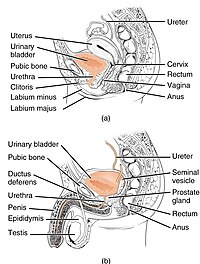
Photo from wikipedia
Introduction and hypothesisPersistent and de novo symptoms decrease satisfaction after urogynecologic surgery. We investigated whether the preoperative bladder microbiome is associated with urinary symptoms prior to and after urogynecologic surgery.MethodsOne… Click to show full abstract
Introduction and hypothesisPersistent and de novo symptoms decrease satisfaction after urogynecologic surgery. We investigated whether the preoperative bladder microbiome is associated with urinary symptoms prior to and after urogynecologic surgery.MethodsOne hundred twenty-six participants contributed responses to the validated OABq symptom questionnaire. Catheterized (bladder) urine samples and vaginal and perineal swabs were collected immediately preoperatively. Bacterial DNA in the urine samples and swabs was sequenced and classified.ResultsPreoperative symptom severity was significantly worse in sequence-positive patients. Higher OABq Symptom Severity (OABqSS) scores (more symptomatic) were associated with higher abundance in bladder urine of two bacterial species: Atopobium vaginae and Finegoldia magna. The presence of Atopobium vaginae in bladder urine also was correlated with its presence in either the vagina or perineum.ConclusionsTwo specific bacterial species detected in bladder urine, Atopobium vaginae and Finegoldia magna, are associated with preoperative urinary symptom severity in women undergoing POP/SUI surgery. The reservoir for Atopobium vaginae may be adjacent pelvic floor niches. This observation should be validated in a larger cohort to determine whether there is a microbiologic etiology for certain preoperative urinary symptoms.
Journal Title: International Urogynecology Journal
Year Published: 2018
Link to full text (if available)
Share on Social Media: Sign Up to like & get
recommendations!